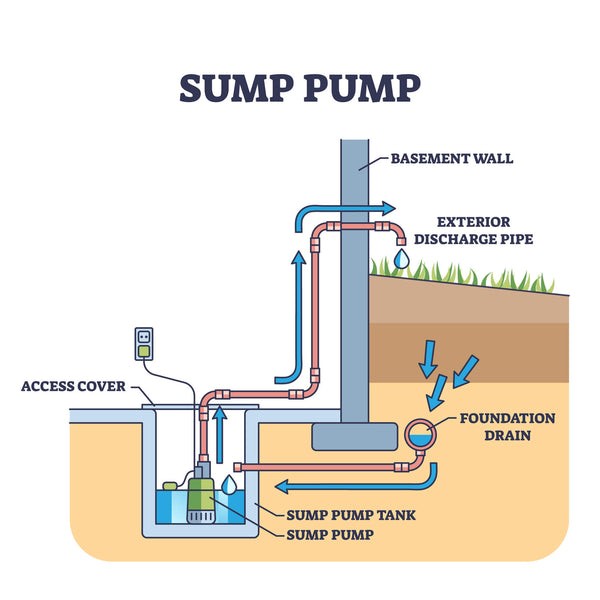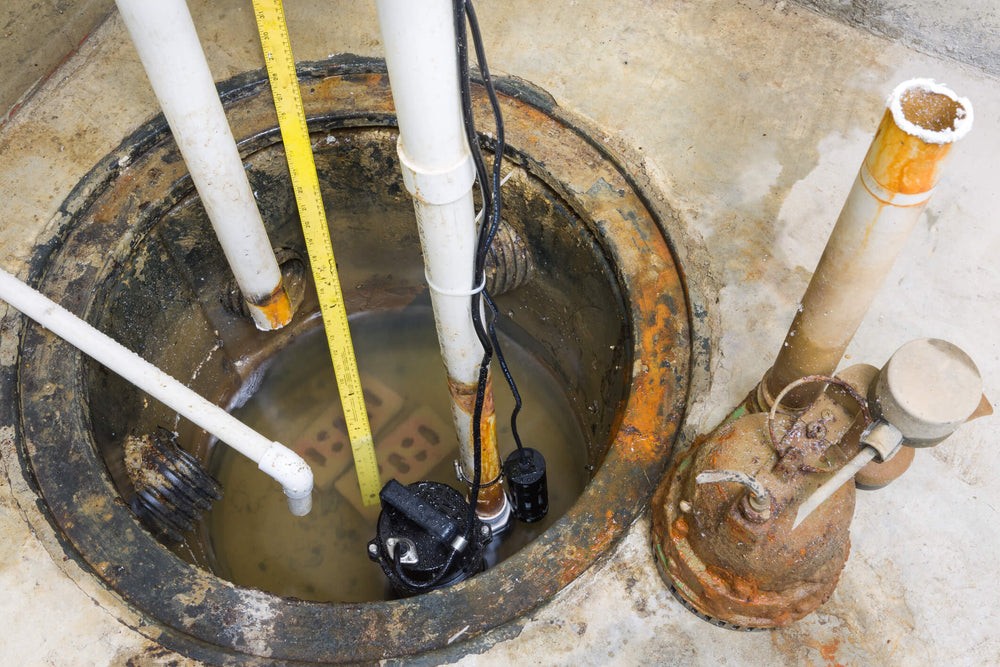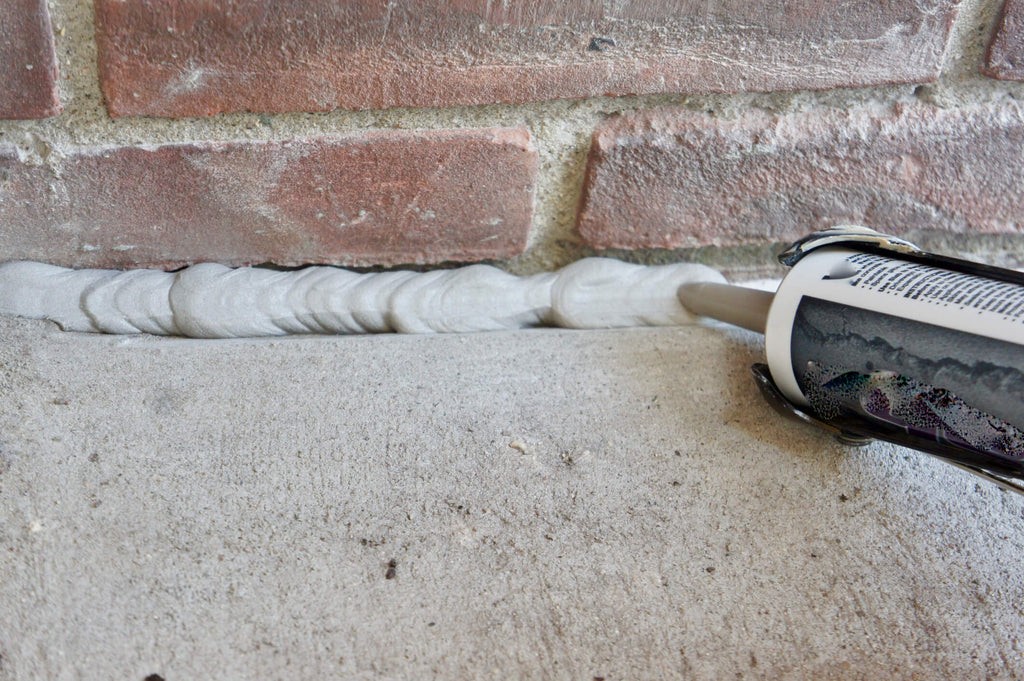What Is A Sump Pump? This device is your primary defense against basement flooding and water damage, and WHAT.EDU.VN is here to provide you with a comprehensive guide. By understanding its function, types, and maintenance, you can protect your home effectively, preventing costly repairs and health hazards related to moisture. Explore the essential aspects of this home appliance, including its installation and the long-term advantages of using a reliable water removal system, safeguarding your home from potential water-related issues and costly water damage.
1. What is a Sump Pump?
A sump pump is a crucial piece of equipment designed to prevent basement flooding by removing excess water. Essentially, it’s a pump installed in a specially constructed pit, known as a sump or basin, typically located in the lowest part of your basement or crawl space. This basin collects water that accumulates due to rain, groundwater seepage, or other sources. The primary function of a sump pump is to automatically pump this water away from your home’s foundation, preventing it from entering and causing damage.
Sump pumps safeguard your home from structural damage, mold growth, and potential health problems associated with damp environments. By effectively managing water levels, they ensure a dry and healthy living space.
2. How Does a Sump Pump Work?
The operation of a sump pump is relatively straightforward:
- Water Collection: Water naturally flows into the sump basin, either through the soil surrounding your home’s foundation or via a drainage system.
- Water Level Detection: The sump pump is equipped with a sensor, typically a float switch or a pressure sensor, that monitors the water level in the basin.
- Automatic Activation: When the water level reaches a predetermined point, the sensor activates the pump.
- Water Removal: The pump motor starts, and water is drawn up through an intake pipe and expelled away from your home via a discharge pipe.
- Deactivation: Once the water level drops below a certain threshold, the sensor deactivates the pump, and the process repeats as needed.
Sump pumps are designed to operate automatically, providing continuous protection against flooding without requiring manual intervention.
3. Do I Need a Sump Pump?
Determining whether you need a sump pump depends on several factors related to your home’s location, construction, and history:
- History of Flooding: If your basement has flooded in the past, even once, a sump pump is a necessity.
- High Water Table: Homes built in areas with a high water table are at greater risk of water seepage into the basement.
- Poor Drainage: If your property has poor drainage, causing water to pool near the foundation, a sump pump can help prevent water from entering your basement.
- Basement Usage: Even if flooding is rare, a sump pump can protect valuable belongings and prevent mold growth in a finished basement.
Consider these factors to determine if a sump pump is right for you.
4. Where Should a Sump Pump Discharge?
Proper discharge of water from a sump pump is crucial to prevent it from returning to your foundation. Ideal discharge locations include:
- Dry Well: A dry well is an underground structure designed to collect and slowly release water into the surrounding soil.
- Creek or Pond: Discharging into a natural body of water is acceptable, provided it complies with local regulations.
- Neighborhood Drain: Some communities have designated drainage systems for sump pump discharge.
Important Considerations:
- Distance: The discharge point should be at least 10 to 20 feet away from your home’s foundation.
- Local Codes: Always check with your local government for building codes and regulations regarding sump pump discharge.
- Avoidance: Never discharge water onto neighboring properties or areas where it could refreeze and create hazards.
alt: Illustration of a residential sump pump system installed in a basement, showing water flow and discharge pipe.
5. Types of Sump Pumps
There are several types of sump pumps, each with its own advantages and disadvantages. Here’s a breakdown of the most common types:
5.1. Submersible Sump Pumps
Submersible sump pumps are designed to be fully immersed in the sump basin. They offer several advantages:
- Quiet Operation: Being submerged in water dampens the noise of the motor.
- Space Saving: They take up less space in the basement compared to pedestal pumps.
- Clog Resistance: The design reduces the likelihood of clogging.
However, they may have a shorter lifespan due to the constant exposure to water. Despite this, submersible pumps are ideal for homes with significant flooding concerns.
5.2. Pedestal Sump Pumps
Pedestal sump pumps have the motor mounted on a pedestal above the sump basin, with a hose extending down into the water. Their benefits include:
- Longer Lifespan: The motor is not submerged, reducing the risk of water damage.
- Easy Maintenance: The motor is easily accessible for repairs and maintenance.
On the downside, they tend to be noisier and take up more space compared to submersible pumps.
5.3. Battery-Operated Backup Sump Pumps
Battery backup sump pumps provide extra security against flooding during power outages. These pumps are powered by a battery and automatically kick in when the main pump fails due to a power loss. This ensures continuous protection, especially during storms.
5.4. Water-Powered Backup Sump Pumps
Water-powered backup sump pumps use municipal water pressure to operate. They don’t require electricity or batteries, making them reliable during power outages. However, they can significantly increase your water bill and may not be allowed in some municipalities due to water usage concerns.
6. What is the Best Sump Pump for My Home?
Choosing the best sump pump for your home involves considering several factors:
- Horsepower: The pump’s horsepower should match the flooding potential in your area. Too little horsepower may result in inadequate water removal, while too much can lead to short cycling.
- Material: Sump pumps with a cast iron core tend to last longer than those with plastic or stainless steel components.
- Alarm System: Consider a pump with an alarm to alert you to high water levels or pump failure.
- GPH (Gallons Per Hour): Select a pump with an appropriate GPH rating based on the volume of water it needs to handle.
- Home Size: Consider the size of your home when choosing the right sump pump.
If you are unsure, consult with a professional at WHAT.EDU.VN to determine the best option for your specific needs.
7. Types of Sump Pump Switches
Sump pumps use switches to automatically turn on and off based on water levels. Here are several common types:
7.1. Diaphragm Switch
This type of switch operates based on pressure changes. As water levels rise, the pressure on the diaphragm increases, activating the pump. They are reliable and less prone to getting stuck.
7.2. Pressure Switch
A pressure switch senses the water pressure and triggers the pump when it reaches a specific threshold.
7.3. Vertical Float Switch
The vertical float switch uses a float that slides up and down a rod. As the water level rises, the float triggers the pump.
7.4. Tethered Float Switch
This switch is attached to the pump and floats in the basin. When the water rises, the switch sends an electrical signal to activate the pump.
7.5. Electronic Switch
Electronic switches use sensors to detect water pressure and activate the pump without a float.
8. Sump Pump Accessories
Consider these accessories to enhance your sump pump system:
- Water Alarm: Provides an alert when the sump pump fails and water levels rise.
- Discharge Hose: Extends the drainage point away from your home’s foundation.
- Check Valve: Prevents water from flowing back into the sump basin after being pumped out.
These accessories can provide added protection and peace of mind.
9. Cost of Sump Pump Installation
The cost of sump pump installation varies based on several factors:
- Type of Pump: Submersible pumps typically cost between $100 and $400, while commercial-grade pumps can range from $500 to $1000.
- Labor Costs: Professional installation can range from $600 to $3000, depending on the complexity of the job.
While DIY installation can save money, professional installation ensures the pump is properly installed and functioning correctly.
10. Factors That Impact Sump Pump Cost
Several factors can influence the overall cost of a sump pump system:
10.1. Type of Sump Pump
The type of pump, its material, horsepower, and additional features all contribute to the cost.
10.2. Basement Material
The type of basement floor (e.g., concrete) can affect installation costs, as it may require additional labor to create the sump basin.
10.3. Drainage
Extending drainage lines or hoses to comply with local regulations can increase costs.
10.4. Permits
Permit costs vary by location and should be factored into the overall project budget.
10.5. Licensed Professional
Hiring a licensed professional ensures proper installation but also adds to the cost.
11. How Long Do Sump Pumps Last?
Sump pumps typically last between 7 and 10 years, depending on usage and maintenance. Regular maintenance can extend the lifespan of your pump.
alt: Close-up of a technician replacing an old sump pump in a basement sump pit during a maintenance service.
12. Do I Need a Battery Backup Sump Pump?
A battery backup sump pump is highly recommended, especially if you live in an area prone to power outages. It provides essential protection when the primary pump fails due to a loss of electricity.
13. Signs of a Faulty Sump Pump
Recognizing the signs of a failing sump pump can help you prevent costly water damage:
- Loud Noises: Unusual noises indicate potential motor problems or blockages.
- Constantly Running: A pump that runs continuously may be undersized or have a faulty switch.
- Cycling Irregularly: Frequent on-off cycling can strain the pump and shorten its lifespan.
- Old Age: If your pump is over ten years old, it’s likely nearing the end of its lifespan.
13.1. Loud Noises
Loud noises such as rattling, clanging, or screeching can indicate a damaged impeller or motor.
13.2. Constantly Running
A pump that runs continuously may have a jammed float switch or be too small for the job.
13.3. Cycling Irregularly
Short cycling can be caused by a float valve positioned too low or a pump that is not powerful enough.
13.4. Old Age
Regularly replacing an old pump reduces the risk of failure and water damage.
14. Sump Pump Alternatives
While sump pumps are highly effective, several alternatives can help manage water around your home:
14.1. French Drains
French drains create paths of least resistance for water to drain, preventing pooling and flooding.
14.2. Waterproofing Compound
Applying waterproof caulking compound to cracks in basement walls can reduce water seepage.
14.3. Gutter Maintenance
Regularly cleaning gutters and downspouts ensures proper water drainage away from the home.
14.4. Sloping the Ground
Proper grading around your home ensures that water flows away from the foundation.
alt: A worker applies waterproof caulking compound to seal a crack in a basement wall, preventing water from seeping through.
15. Frequently Asked Questions (FAQs) About Sump Pumps
Here are some common questions related to sump pumps:
| Question | Answer |
|---|---|
| How often should I replace my sump pump? | It’s generally recommended to replace your sump pump every 7 to 10 years, even if it appears to be functioning correctly. |
| Can I install a sump pump myself? | While it’s possible to install a sump pump yourself, professional installation is recommended to ensure proper setup and prevent future problems. |
| What size sump pump do I need? | The size of the sump pump depends on the amount of water it needs to handle. Factors include the size of your basement, the frequency of flooding, and the depth of the water table. |
| How do I maintain my sump pump? | Regular maintenance includes cleaning the sump pit, checking the float switch, and ensuring the discharge pipe is clear of obstructions. |
| What causes a sump pump to fail? | Common causes of sump pump failure include old age, mechanical issues, power outages, and improper installation. |
| Are sump pumps noisy? | Submersible sump pumps are generally quieter than pedestal pumps. Regular maintenance can also help reduce noise. |
| Can a sump pump run dry? | Running a sump pump dry can damage the motor. It’s important to ensure the pump is submerged in water when operating. |
| Do I need a permit to install a sump pump? | Permit requirements vary by location. Check with your local government to determine if a permit is required. |
| What is a check valve? | A check valve prevents water from flowing back into the sump basin after being pumped out. It helps improve the efficiency of the pump and reduce wear and tear. |
| How do I prevent my sump pump from freezing? | Insulate the discharge pipe to prevent freezing. Consider installing a freeze-resistant discharge pipe or a weep hole to allow water to drain back into the sump pit. |
| Can I connect my sump pump to the sewer line? | Connecting a sump pump to the sewer line is typically prohibited by local regulations. Always discharge water to an approved location, such as a dry well or designated drainage area. |
| What is the ideal depth for a sump pit? | The ideal depth for a sump pit is typically around 24 to 30 inches, but it can vary depending on the specific needs of your home. |
| What is the difference between a sump pump and an ejector pump? | A sump pump removes groundwater from around the foundation of a building, while an ejector pump removes wastewater from plumbing fixtures located below the main sewer line. |



Sump Pump Troubleshooting Guide
| Problem | Possible Causes | Solutions |
|---|---|---|
| Sump pump won’t turn on | – No power supply – Tripped circuit breaker – Float switch is stuck | – Check power cord and outlet – Reset circuit breaker – Inspect and free the float switch |
| Sump pump runs constantly | – Float switch is stuck – Incorrect pump size – Clogged impeller | – Inspect and free the float switch – Consult with a professional to determine the correct pump size – Clean the impeller |
| Sump pump is making loud noises | – Debris in the impeller – Worn-out motor bearings – Improper installation | – Clean the impeller – Replace motor bearings – Ensure proper installation and alignment |
| Water is not being pumped out | – Clogged discharge pipe – Frozen discharge pipe – Impeller is damaged | – Clear the discharge pipe – Thaw the discharge pipe – Replace the impeller |
| Sump pit is overflowing | – Pump is not powerful enough – Discharge pipe is blocked – Check valve is malfunctioning | – Upgrade to a more powerful pump – Clear the discharge pipe – Replace the check valve |
| Sump pump cycles on and off frequently | – Float switch is set too low – Small sump pit – Backflow of water into the pit | – Adjust the float switch – Increase the size of the sump pit – Install a check valve |
| Sump pump runs but does not remove water | – Clogged intake screen – Air lock in the pump – Damaged impeller | – Clean the intake screen – Prime the pump to remove air lock – Replace the impeller |
| Foul odor from sump pit | – Bacteria growth – Stagnant water – Debris accumulation | – Clean the sump pit and disinfect with bleach solution – Ensure proper drainage and ventilation – Remove any debris from the pit |
16. Need Help with Your Sump Pump? Ask WHAT.EDU.VN!
Protecting your home from water damage is essential, and a properly functioning sump pump is a critical component of that protection. From understanding what a sump pump is to knowing how to maintain it, this guide provides a comprehensive overview.
Do you have more questions or need personalized advice? Don’t hesitate to reach out to the experts at WHAT.EDU.VN! We’re here to provide free answers and expert guidance to ensure your home stays dry and protected.
Contact Us Today:
- Address: 888 Question City Plaza, Seattle, WA 98101, United States
- WhatsApp: +1 (206) 555-7890
- Website: WHAT.EDU.VN
Don’t let water damage become a costly problem. Visit what.edu.vn and ask your questions today for free answers and expert advice! We’re committed to helping you keep your home safe and dry, offering support every step of the way.
